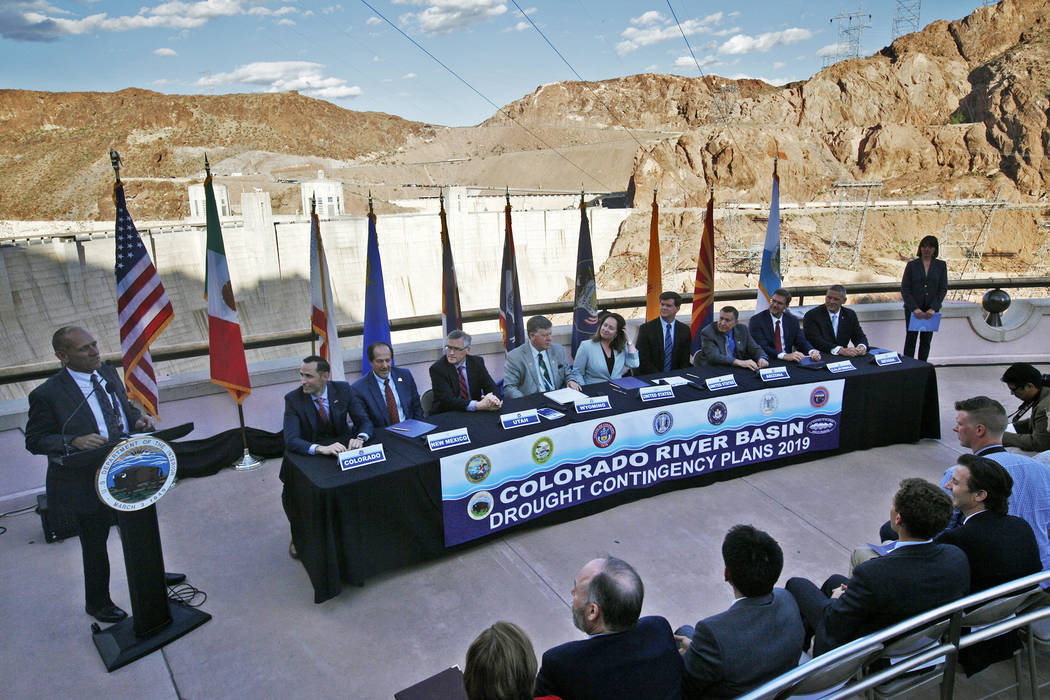Officials celebrate Colorado River drought deal at Hoover Dam

Top water officials from across the Southwest gathered at the Hoover Dam on Monday to celebrate the completion of emergency drought plans for the Colorado River.
From an observation deck overlooking the dam, federal regulators and representatives of the seven states that share the river signed the last of the legal documents needed to enact the so-called Drought Contingency Plans.
“The Colorado is the single most important water resource in the southwestern United States and northwestern Mexico,” said Bureau of Reclamation Commissioner Brenda Burman. “These (plans) reduce the risks that face everyone who relies on the Colorado River.”
The cooperative plans call for Nevada, Arizona and, eventually, California to voluntarily cut their river usage and leave more water in Lake Mead. Meanwhile, Colorado, New Mexico, Utah and Wyoming have pledged to send more water downstream to prop up Lake Powell and protect hydropower generation at Glen Canyon Dam.
The signing ceremony took place within sight of one of the drought’s most startling monuments: the bleached-white bathtub ring on the cliffs around Lake Mead marking a 130-foot drop in the water level since 2000.
Barring a sharp and unexpected rise in the lake in the coming months, the first round of annual cuts is expected to hit in January, when Arizona will give up 192,000 acre-feet of water and Nevada will give up 8,000 acre-feet.
One acre-foot is enough water to supply two average Las Vegas Valley homes for just over a year. Southern Nevada Water Authority General Manager John Entsminger said the community has already conserved more than enough water to easily absorb the cuts.
The completion of the drought plans also activates a series of voluntary reductions by Mexico, which agreed to leave more of its river water in Lake Mead several years ago pending the deal among the seven states.
Mexico’s first contribution to Lake Mead of 41,000 acre-feet could come next year.
California would join in the voluntary cuts only if the lake’s water level drops 42 feet from where it is now.
Negotiations on the hard-fought deal took years, 2,152 days to be exact from the first meeting to the last, according to Terry Fulp, lower Colorado regional director for the bureau.
In the end, it was signed without the river’s largest water user.
California’s Imperial Irrigation District, which draws more from the Colorado than any other entity, refused to sign the pact because it doesn’t address the growing environmental threat posed by the shrinking Salton Sea.
The massive agricultural water supplier filed suit in California last month, claiming that the drought plan could violate state environmental laws.
Jeffrey Kightlinger, general manager of the Metropolitan Water District of Southern California, said his agency is still in talks with Imperial over a compromise he hopes will lead to the irrigation district joining the multistate river deal.
“But we are in litigation as well,” Kightlinger said.
Entsminger said “it’s always better if everyone is involved,” but Imperial’s decision not to participate won’t affect the larger deal. California has committed to leaving the same amount of water in Lake Mead regardless, he said.
“I think the most important takeaway for Nevada residents is that seven states and two countries are working cooperatively to ensure the reliability of the Colorado River,” Entsminger said from the Hoover Dam observation deck. “There really is no more important natural resource to Nevada than this river.”
Contact Henry Brean at hbrean@reviewjournal.com or 702-383-0350. Follow @RefriedBrean on Twitter.
Contact Henry Brean at hbrean@reviewjournal.com or 702-383-0350. Follow @RefriedBrean on Twitter.